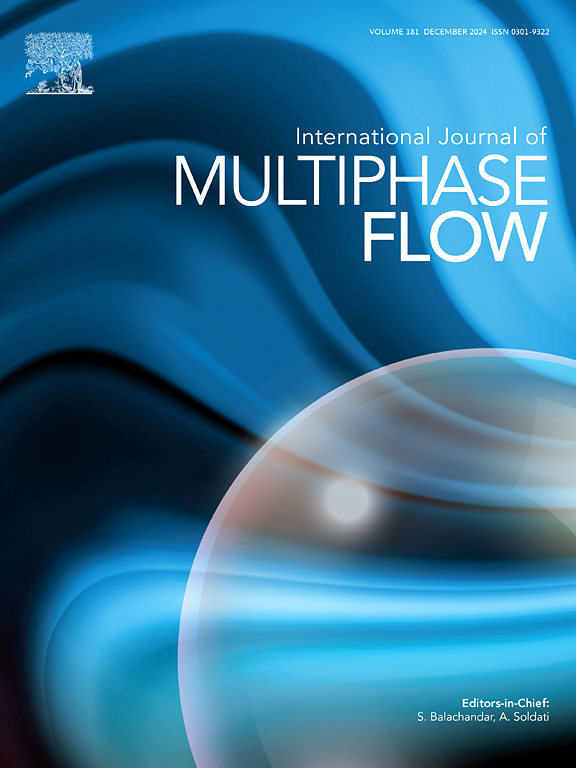Investigation of the fouling layer growth using coupled immersed boundary and Eulerian-Lagrangian methods
IF 3.6
2区 工程技术
Q1 MECHANICS
International Journal of Multiphase Flow
Pub Date : 2025-04-11
DOI:10.1016/j.ijmultiphaseflow.2025.105241
引用次数: 0
Abstract
This study presents a numerical simulation of fouling, focusing on the complex, unsteady, multiphase, and turbulent process of fouling layer growth on the outer surface of a heat exchanger's pipe. Addressing the fundamental challenges associated with fouling phenomenon, an Eulerian-Lagrangian approach is employed, wherein the Eulerian method calculates continuous phase flow parameters, such as velocity and pressure, and the Lagrangian method precisely tracks particles near the surface. The immersed boundary method is utilized to simulate fouling layer growth without altering the underlying grid, effectively reducing computational cost compared to dynamic mesh methods. The model is validated against experimental data involving ash particle deposition on a cylindrical surface. Key parameters, including Young's modulus, Reynolds number, and particle size distribution, are systematically analyzed. The findings reveal that particles smaller than 10 micrometers can penetrate the rear of the cylinder, while larger particles (25-30 micrometers) predominantly accumulate on the front, exhibiting nearly double the deposition frequency compared to smaller particles. As particle diameter increases, both Young's modulus and flow velocity contribute to a reduced settling rate by lowering the critical deposition velocity. A higher Reynolds number results in a 67 % reduction in fouling mass due to decreased adhesive velocity and enhanced particle detachment. Additionally, larger particles tend to migrate towards the edges of the heat exchanger tube, promoting a more uniform surface distribution. Notably, at elevated Young's modulus values (e.g., 50,000 MPa), particle deposition on the surface is virtually eliminated.

使用沉浸边界和欧拉-拉格朗日耦合方法研究污垢层的生长情况
本研究介绍了污垢的数值模拟,重点是换热器管道外表面污垢层生长的复杂、非稳态、多相和湍流过程。为了应对与污垢现象相关的基本挑战,我们采用了欧拉方法,其中欧拉方法计算速度和压力等连续相流参数,而拉格朗日方法则精确跟踪表面附近的颗粒。利用沉浸边界法模拟污垢层的生长,无需改变底层网格,与动态网格法相比,可有效降低计算成本。该模型根据灰尘颗粒在圆柱表面沉积的实验数据进行了验证。对包括杨氏模量、雷诺数和粒度分布在内的关键参数进行了系统分析。研究结果表明,小于 10 微米的颗粒可以穿透圆柱体的后部,而较大的颗粒(25-30 微米)主要聚集在前部,沉积频率几乎是较小颗粒的两倍。随着颗粒直径的增加,杨氏模量和流速都会降低临界沉积速度,从而降低沉积率。较高的雷诺数可使污垢质量减少 67%,这是由于粘附速度降低和颗粒脱离增强所致。此外,较大的颗粒倾向于向热交换器管的边缘迁移,从而使表面分布更加均匀。值得注意的是,当杨氏模量值升高时(例如 50,000 兆帕),颗粒在表面的沉积几乎消失。
本文章由计算机程序翻译,如有差异,请以英文原文为准。
求助全文
约1分钟内获得全文
求助全文
来源期刊
CiteScore
7.30
自引率
10.50%
发文量
244
审稿时长
4 months
期刊介绍:
The International Journal of Multiphase Flow publishes analytical, numerical and experimental articles of lasting interest. The scope of the journal includes all aspects of mass, momentum and energy exchange phenomena among different phases such as occur in disperse flows, gas–liquid and liquid–liquid flows, flows in porous media, boiling, granular flows and others.
The journal publishes full papers, brief communications and conference announcements.

 求助内容:
求助内容: 应助结果提醒方式:
应助结果提醒方式:


